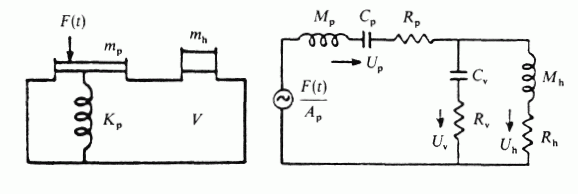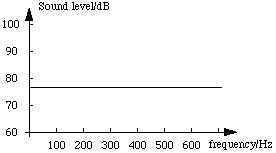|
Acoustic Concepts/Measurement Technique
"Pythagoras was first guided to the notion that mathematics held a key to understanding nature by observations of the relation between musical intervals and natural numbers"*
- Acoustic Radiation Patterns
- Spectral Responses
- Time Domain/Envelope
A very large range of acoustical concepts can be derived that have the same form as those in electronics or general mechanics, such as impedance (and resistance), conductivity, capacitance and radiation.
We can construct acoustic mechanical models (eg. using simple springs as acoustic resonators) and acoustical 'circuits' (eg. using resistors to represent acoustic impedance, AC power sources for an applied oscillatory sound ('tone').)
For example, here are equivalent mechanical and electrical schemes for a binary oscillator model of top-plate/air cavity coupling for the guitar (assuming a rigid back and sides):

Sketch of mechanically and electrically equivalent systems. Left: Two-Mass Analogue. Right: Electrical Circuit Analogue.**
The science of acoustics may not be able to answer all of the musical questions asked, but it certainly plays a vital role in objectifying quantities such as frequency, sound intensity, gain, sustain etc., as they are produced by various instruments and techniques of playing.
For the guitar specifically, we can examine three acoustical qualities:
- Acoustic Radiation Patterns
Acoustic radiation patterns are formed due to the way the guitar vibrates in its various resonant modes. The patterns are just a map of how the sound intensity varies with the angle and distance from the instrument.
The total sound intensity at your ear at is not only dependent upon the frequency (pitch) the guitar is played at, but at what distance and angle your ear is to the instrument.
Guitar radiation patterns tend to be anisotropic - how loud the instrument is depends on what angle your ear is to the instrument. For example, an "A3" note (110 Hz, typically close to a steel-string's monopole air resonance) may not sound much louder at various angles from the guitar (keeping the same distance!), but a "B4" (247 Hz, close to a standard steel-string's top-plate dipole resonance) you may find that you hear a noticeably different sound intensity at various angles. Try it out!
{Sketch of angular dependence on intensity}
Sketch of angular dependence of sound intensity, guitar in dipole mode
The complicated patterns formed in space due to the various modes of the guitar is one of the reasons it is so hard to capture that 'live' sound on recordings. A lot of people like listening to 'live' music because of the complex change in sounds as you move around.
- Spectral Response
A sound spectrum is a plot of how the intensity of a particular sound varies with frequency. A useful way of looking at a sound produced by an instrument is to examine its spectral response.
A typical way to measure an instrument's spectral response is to excite the instrument with some sort of mechano-acoustic oscillator, such as:
- A speaker attached directly; or
- A solenoid (electromagnet) magnetically influencing a rare-earth magnet attached to the instrument.
Diagram of various apparatus used to measure spectral response. Left: Speaker-driven system. Right: Solenoid-driven system.
The oscillator is connected to a function generator (usually connected to a computer) which 'scans' over a frequency range. A transducer such as a microphone converts the resulting output signal into an electrical one, at a fixed point; a spectrum can then be plotted.
The spectral response can tell a lot about a particular instrument, showing characteristics, including the main resonances and how sharp they are.
A flat response represents an equal intensity of sound produced at every frequency, yet a guitar generally has a series of peaks and valleys:
 |
 |
Comparison of two spectral responses. Left: Flat response (even weight over the tonal range). Right: Typical response from musical instrument.
It actually turns out that most people seem to prefer a varied, rather than flat, response. The interesting shapes in a response curve are sometimes called features and our mind is very good at recognising features - perhaps most people's minds prefer the complexity of spectral features inherent to most traditional instruments, rather than the simpler 'pure' tones characterised by a flat response.
- Intermediate Timescale Phenomena
Intermediate timescale phenomena refer to acoustic events noticeable on a more moderate timescale (of the order of 10ms or less). In a way, this really applies mostly to envelope effects.
*"The Acoustics of Stringed Musical Instruments", M.E. McIntyre & J. Woodhouse. Interdisciplinary Science Reviews, 3, pp.157-173 (1978)
**from Fletcher, N. and Rossing, T. "The Physics of Musical Instruments" (2nd ed.) ©1998, Springer-Verlag New York Inc.
*** "Comparison between Experimental and Predicted Radiation of a Guitar", A. Le Pichon, S. Berge & A. Chaigne. Acta Acustica 84, pp.136-145 (1998)
***"Radiation from the Lower Guitar Modes" G. Caldersmith. American Lutherie, 2, pp.20-24 (1985)
|

